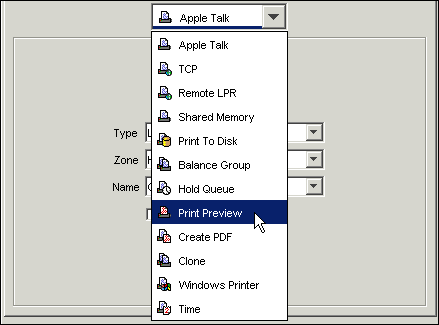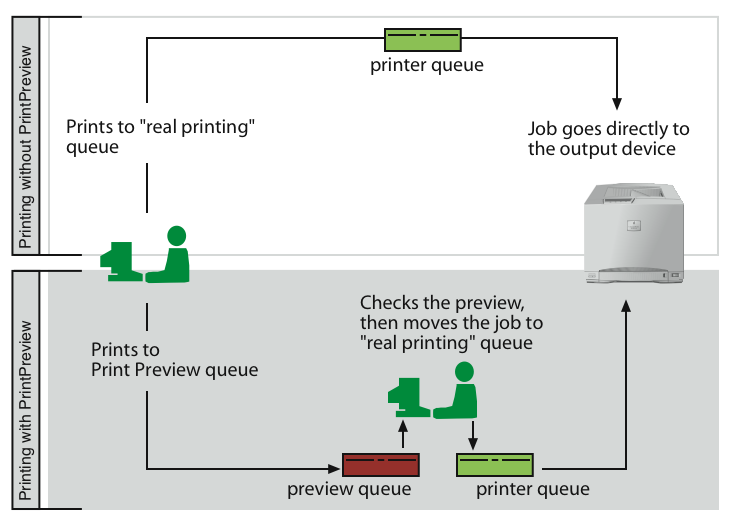2 An introduction to HELIOS PrintPreview
PrintPreview generates accurate color-matched proofs of PostScript and PDF1 print jobs. Files are rendered as bitmapped pages into a PDF file. It is ideal for preflighting, local and remote proofs throughout the production cycle, and serves as a final job check prior to printing.
- Note:
-
HELIOS PrintPreview runs on top of the foundation provided by HELIOS Base. Please read the HELIOS Base manual for installation instructions and other important details.
2.1 New PrintPreview features
For new features in the PrintPreview software see the HELIOS website:
www.helios.de Go to What is new in UB2.
For HELIOS Base, the foundation used by all HELIOS products, see the HELIOS Base product web page:
www.helios.de Go to Products > HELIOS Base.
2.2 Product description
PrintPreview receives PostScript print jobs (separated or composite), via HELIOS print queues. It then converts the PostScript file into a bitmap file, and saves the bitmapped pages of the separations, and/or a color-matched composite preview, in a PDF “wrapper”, for easy viewing and printing, either locally or remotely. PrintPreview utilizes the final printer PPD to provide accurate previews of all job elements included in the PostScript: fonts, graphics, page geometry, trapping, imposition, colors, spot colors, etc. The composite preview can be color matched using the final printer ICC profile, along with your monitor or proof printer’s ICC profile, for easy soft proofing or printing to any laser or inkjet proof printer. Upon approval, the original job (i.e. the original PostScript) can be released for production into the final printer queue.
The built-in ICC based color management provides accurate color matched composite previews, using the Heidelberg CMM (Color Matching Module), co-developed by Heidelberger Druckmaschinen AG and HELIOS Software GmbH. Prior versions were licensed to Apple Computer for use in Mac OS 9 as the ColorSync 2.6 CMM.
Real printing of the jobs you have checked can be started automatically or manually. This gives you maximum control over your production and can help you save time and money.
PrintPreview is fully integrated with the other HELIOS server products. ImageServer and PDF HandShake are optional, and are tightly integrated to work smoothly with PrintPreview. WebShare facilitates the remote viewing and transfer of proofs.
Technically speaking, PrintPreview is a special kind of
printer queue – it adds another option to the
Connection pulldown menu you use when setting
up a new printer queue (Fig. 2.1).
Fig. 2.2 shows a simple “preview-then-print” workflow. The illustration compares a print-only environment to an environment, where PrintPreview is used.
You have several possibilities of forwarding a print job from the preview queue to a printer queue: you can do it manually (by “drag-and-drop”) as illustrated in Fig. 2.2, or you can configure the program to do it automatically. This flexibility allows you to adapt PrintPreview to individual environments.
![]() If you print from your current application to a
If you print from your current application to a
Print Preview
queue, the software “prints” into
a PDF file which can then be opened with
Adobe Acrobat. You can check the fonts and
colors, the composite preview and all separation plates of
each page you have printed. The generated PDF file is
meant to serve as a screen proof, but it can also be saved for
future use, and it can even be printed from Acrobat if
desired. Note that each page of the PDF file is one image
and you will not be able to edit text or other elements on a
page.
Many sites print from an application to create a PDF for remote proofing purposes. These PDFs contain all content as separate bitmap and vector objects. However, it is quite possible that some of these elements (e.g. fonts or OPI images) may not be available on the print server. Or, certain PDF features may not be supported by the final RIP (e.g. CID fonts, TrueType fonts, DeviceN). Hence, a standard PDF will show only what is supposed to be printed, which may not be an accurate preview of what will actually be printed. In addition, a standard PDF usually uses the Acrobat Distiller or similar device-independent PPD. When the print job is printed to a real world printing device, with a different PPD, the results can be quite different.
PrintPreview, on the other hand, is a “virtual printer”, using the final output device PPD, so the rastered pages in the PrintPreview PDF will accurately preview the final device output.
- 1 PDF separations via PDF HandShake or Acrobat Professional.

